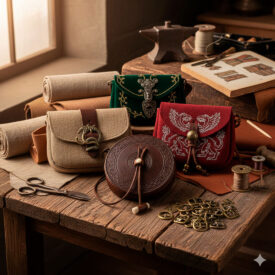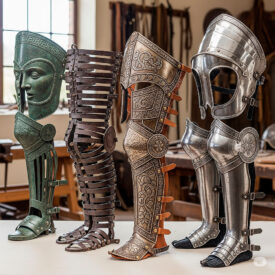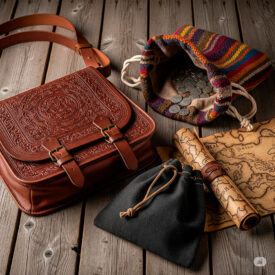Have you ever wondered how men and women in the Middle Ages stored their belongings? In an era without pockets as we know them today, the bag was not a mere accessory; it was a vital extension of the individual, a reflection of their status, and an indispensable companion in daily life. Delve with us into the fascinating world of medieval bags and discover the five essential types that every historical reenactment enthusiast should know to complete their attire with authenticity and style.
The Evolution of the Medieval Bag: A Look Through Time
Bags and purses were an essential accessory from the early days of the Early Middle Ages until the end of the period. Their function and design evolved with society, adapting to the needs and fashions of each century. From simple Celtic pouches to elaborate alms purses, each piece has a story to tell.
| Era | Event |
|---|---|
| Early Middle Ages (5th–8th centuries) | |
| Celtic Pouch / Early Bags | Use of small bags hung from the belt made of leather or wool (pouch). They held personal belongings (jewelry, cosmetics). They indicate the continued use of bags in the general absence of pockets. |
| Viking Period / 9th century | |
| Birka Bags (9th century) | Archaeological example: Viking brown pigskin leather bag (≈18×23 cm) that closed with a strap. It shows leather cutting and sewing techniques for utilitarian bags. |
| Late Early Middle Ages – Early High Middle Ages (10th–11th centuries) | |
| Pilgrim’s Scrip | Appearance and generalization of pilgrim bags/backpacks (scrip) hung from the neck, containing food, clothes, utensils, money, and ex-votos. A distinctive element of the medieval pilgrim, frequent during large pilgrimage flows (11th–13th centuries onwards). |
| High Middle Ages (12th century) | |
| Initial Representations of Alms Purses | Early medieval iconography shows alms purses hanging from the belt (e.g., effigy of Queen Berengaria, wife of Richard I). It indicates the visible use of the bag in noble and religious contexts. |
| Full 13th century | |
| Alms Purse: Function and Luxury (13th century) | The alms purse, an emblematic symbol, was used both to collect alms and to store money and everyday objects (rosaries, combs, handkerchiefs). More frequent representations and descriptions from the 13th century; noble versions in velvet, silk, and gold thread embroidery. |
| Gipsers and Guild Mentions (13th century) | Leather purses (gipsers) with silk tassels and metallic decorations (latoun). In Paris (Livre des Métiers, 13th–14th centuries), alms purse makers were documented, and the denomination of pieces like “sarrazinoises” appeared. |
| Security Systems (13th century) | Innovations to protect content: openings or “slits” in the surcoat that provided access to the inner belt where the purse was tied, protecting against “bag-cutters.” The documented application of boiled leather (cuir bouilli) for more rigid and decorative pieces began. |
| 13th–14th centuries | |
| Tasses / Tassettes and Luxury Bags | More or less large bags tied to the waist (tasses/tassettes) that replaced pockets. Elaborated with silks, silver/gold threads, and tapestry techniques; sometimes decorated with heraldic emblems or Byzantine motifs (birds, crosses, fleurs-de-lis). |
| Purse Maker’s Trade and Textile Production (late 13th–14th–15th centuries) | Documentation of the purse maker’s trade (bursarie) from the late 13th century. In Gothic Barcelona (14th–15th centuries), professional embroiderers produced bags and gandayas (net headdresses), using silk and gold thread; specialization reveals aristocratic demand. |
| 14th century | |
| Leather Belt Pouch (14th century) | A type of bag attached to the belt by two loops was documented, exclusively associated with male use: tight breeches prevented carrying objects in clothing and favored the use of hanging bags. |
| 15th century (and transition to 16th) | |
| Barjoletas and Metal Closures (15th–16th centuries) | Leather containers for personal materials (clothing, writings, money, instruments). In southern Spain (Córdoba), cordovan was required for barjoletas; many closed with iron locks and padlocks with keys, increasing security. |
| Gandayas and Late Medieval Fashion (14th–15th centuries) | Gandayas (net headdresses often worn with accessory bags) and fine bags associated with female and courtly fashion. Ornamentation with silk, gold, and stones indicated status. |
| Widespread Use and Continuous Typologies (11th–15th centuries) | |
| Saddlebags, Sacks, and Transport Containers | For transporting goods and during travels, saddlebags, sacks, bundles, and large bags made of coarse fabrics (serge, sackcloth, tow) were used. Widespread use among merchants, peasants, and artisans throughout the Middle Ages. |
| Late Middle Ages: Materials and Status (13th–15th centuries) | |
| Materials and Social Hierarchy | High-status materials: silk, velvet, gold and silver thread, gemstones, and cordovan (goatskin). Common materials: linen, wool, cotton, cowhide, small furs (rabbit, lamb), carved wood. The colors and complexity of the adornment immediately distinguished social status. |
| Linguistic and Historical Protection | The term “escarcela” has medieval connotations despite its later popularization (19th century): it originally referred to a bag hung on the front of the belt, analogous to various medieval purses and bags. |
The Five Essential Medieval Bags for Reenactors
Immerse yourself in history and discover the functionality and symbolism behind these accessories.
1. The Alms Purse: Symbol of Charity and Status
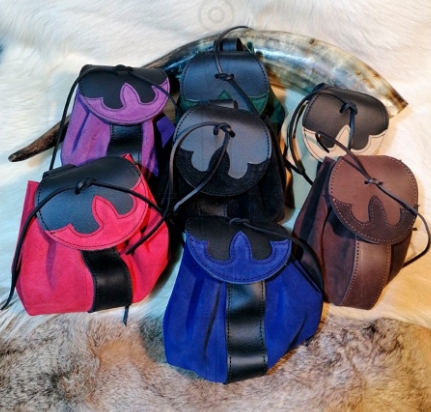
The alms purse, a small bag attached to the belt, was an omnipresent object in medieval society. Used by both men and women, its original purpose was to carry coins for almsgiving, but it soon transcended that function to store everyday objects such as rosaries, combs, or handkerchiefs. Versions for the nobility and clergy were made with sumptuous materials such as velvet and silk finely embroidered with gold and silver threads, reflecting the high status of its wearer.
2. The Girdle Purse: A Universal Accessory
The girdle purse was a type of bag with one or two upper handles designed specifically to hang from the belt. Its versatility made it popular among all social classes, although the material and decoration varied enormously. From humble versions of cowhide or suede for the peasantry, to elaborate pieces of deer or pigskin, with rich details for the nobility, these bags were a testament to the universal need to carry personal items.
3. Bags with Internal Compartments: Medieval Efficiency
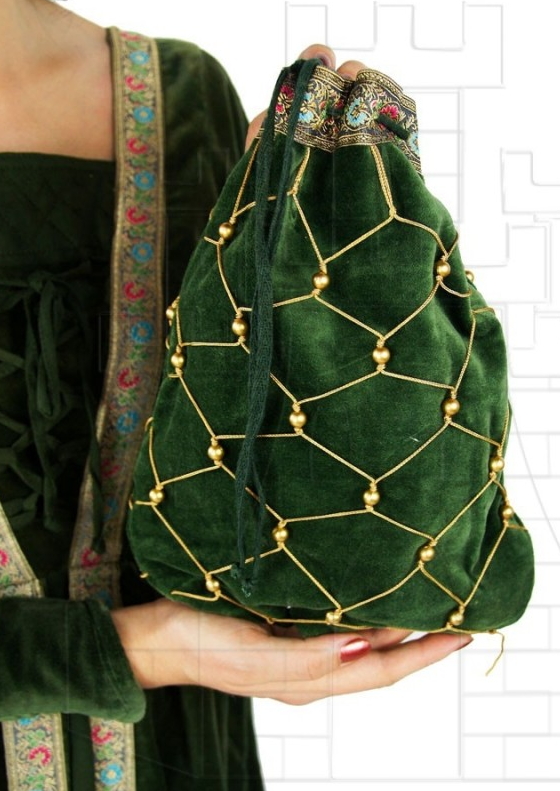
Organization was key, even in the Middle Ages. Bags with internal compartments, or those with small sewn pouches (pouchlets), were highly valued by merchants and artisans for storing coins, seals, or small instruments. These ingenious designs, often made of fine veal or goatskin, offered a practical solution for keeping important items safe and organized. They were a common accessory among the growing bourgeoisie, who needed to carry tools and money securely.
4. The Medieval Backpack (Pilgrim’s Scrip): Travel Companion
For travelers, pilgrims, and soldiers, the medieval backpack, often called a pilgrim’s scrip, was essential. With a larger capacity than waist bags and equipped with shoulder straps, these backpacks made of resistant leather or robust canvases allowed heavier loads to be transported during long journeys, relieving strain on the spine. They contained everything from food and clothes to utensils and ex-votos, being a distinctive element of those who embarked on great journeys.
5. The Net Pouch: Elegance for Female Nobility
Medieval noblewomen, always attentive to fashion and luxury, often opted for the net pouch. These were delicate mesh or woven bags, sometimes crafted with fine metal threads of iron or bronze, and decorated with precious stones or pearls. They were perfect for carrying smaller personal items and added a touch of sophistication to the attire. Not only were they functional, but they also enhanced the status and sophistication of the wearer.
Materials and Social Status: The Silent Language of Bags
In the medieval world, the material and ornamentation of a bag spoke volumes about its owner’s social standing. While the humbler classes opted for cowhide, linen, or wool, nobles displayed bags of silk, velvet, goatskin (cordovan), or calfskin, adorned with sumptuous embroidery, gold and silver threads, and even precious stones. Bright colors and intricate heraldic designs were also signs of wealth and power.
Clearing Up Mysteries About Medieval and Renaissance Bags
What are the main differences between medieval and Renaissance bags?
The main differences between medieval and Renaissance bags are reflected in their style, materials, and purpose:
- Style and Design: Medieval bags were simpler and more practical. With the appearance of fitted clothing, bags were no longer hung from the waist and were carried externally, with “belt bags” decorated according to social status being common. In the Renaissance, bags became works of art, with more elaborate designs and ornaments such as pearls and precious stones.
- Materials: Medieval bags were made from durable materials like leather, while Renaissance bags also included velvet and other luxurious textiles.
- Purpose and Symbolism: In the Middle Ages, bags had a practical function, while in the Renaissance, they also served a symbolic and aesthetic role, reflecting personal fashion and wealth.
- Handbags: During the Renaissance, handbags became popular, reflecting the growing focus on personal fashion.
What materials were most common for making medieval bags?
The most common materials used to make bags in the medieval era were primarily leather, due to its resistance and durability, as well as natural fabrics such as cotton and linen. Animal skins such as deer or pig were also used, especially for simpler bags or for people with fewer resources. For the wealthiest classes, bags could combine leather with embroidered fabrics and metallic or velvet decorative details.
How were medieval bags decorated according to social status?
Medieval bags were decorated according to the social status of their owner through a variety of techniques and materials. The choice of materials and decoration reflected the wealth and social rank of the proprietor. For example:
- Materials: Vegetable-tanned leather bags were common among all social classes, but nobility could opt for more exotic or luxurious materials, such as fine fabrics or metallic adornments.
- Decorations: Decorations included embossed patterns, engravings, stenciling, stamped designs, figurative designs, and punched or perforated decorations. These techniques allowed for the creation of intricate patterns and motifs that symbolized the owner’s social position.
- Social Status: The upper class used bags with more elaborate decorations and expensive materials, while lower classes opted for simpler designs and accessible materials. Metallic adornments, such as clasps and fasteners, also indicated social status, with the most intricate ones being reserved for the nobility.
In general, the decoration of medieval bags was a silent language that spoke of the wealth and social position of their owner in medieval society.
What types of bags were most popular among men and women during the Middle Ages?
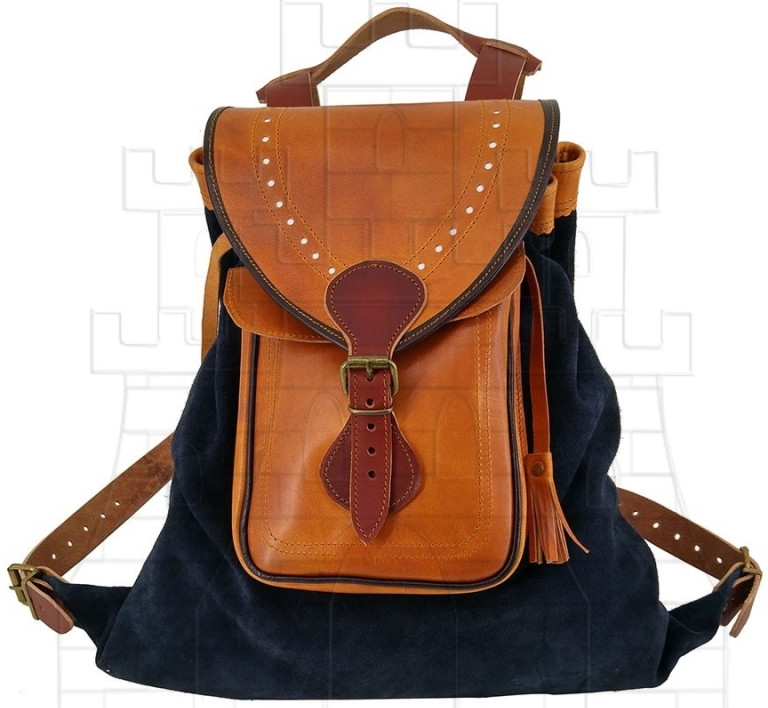
During the Middle Ages, both men and women primarily used small bags or belt pouches, as clothing generally did not have pockets. Men usually carried these bags or purses attached to their waists, as tight breeches prevented them from storing objects in their clothing. Women also used bags, but with greater discretion, often hidden among the folds of their ample dresses or tunics.
Regarding materials and styles, the most common bags were:
- Leather bags, especially goatskin for the wealthiest and cowhide for the less affluent.
- Alms purses, a type of small bag often used by nobles to carry money.
- In some cases, especially among the nobility, more luxurious bags adorned with silks, gold and silver thread embroidery, and even gemstones were used, influenced by Byzantine culture.
The bag, in its various forms, was an important functional accessory and also reflected social status, displaying decoration and materials according to the wearer’s economic position. During the Late Middle Ages (11th to 15th centuries), its use became more visible and began to integrate as an accessory that also signaled personality and social rank.
How did the Industrial Revolution influence the design of medieval bags?
The Industrial Revolution did not directly influence the design of medieval bags, as these two historical periods are separated by several centuries. Medieval bags, which were primarily used between the 5th and 15th centuries, were characterized by being small, decorated, and symbolic, reflecting the social status of their wearers.
However, the Industrial Revolution, which began in the 18th century, brought about significant changes in the production of textiles and accessories. These changes allowed for mass production and the use of new materials, which in turn allowed for a greater variety in bag design during the 18th and 19th centuries. Although this revolution did not directly affect medieval bags, it marked the beginning of an era in which bags became more accessible and varied in design.
The choice of a medieval bag is more than a simple matter of aesthetics; it is a journey through history, a statement of authenticity that enriches any reenactment. Knowing these five essential types will allow you not only to carry your belongings with period style but also to better understand the life and customs of our ancestors.



